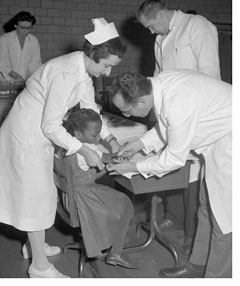 Fifty years ago, Dr. Jonas Salk (below)
and his team helped administer the first polio vaccines. Today,
armed guards in Somalia must accompany health workers on polio
eradication campaigns.
Fifty years ago, Dr. Jonas Salk (below)
and his team helped administer the first polio vaccines. Today,
armed guards in Somalia must accompany health workers on polio
eradication campaigns.
©
2001 Sebastião Salgado/Amazonas Images/Contact Press
Images.
 The
images, many of them heart-wrenching, show the ravages of
a disease that most Americans don’t think about any
more: polio. The
images, many of them heart-wrenching, show the ravages of
a disease that most Americans don’t think about any
more: polio.
While the often-crippling disease has been eradicated in
the United States, other countries haven’t been as
fortunate. Brazilian photographer Sebastião Salgado
captures the face of polio today in his exhibit, End of
Polio: A Global Effort to End a Disease, at Carnegie Museum
of Natural History from March 5 through May 15.
It’s one of several events sponsored this spring
by the University of Pittsburgh to commemorate the 50th
anniversary of the development of the Salk vaccine. Dr.
Jonas Salk and his team worked on the vaccine at the University
between 1947 and 1955, and it was declared “safe,
effective, and potent” on April 12, 1955.
Salgado, an internationally renowned photographer, spent
much of 2001 and 2002 working on the photo project, which
was sponsored by the Global Alliance for Vaccines and Immuni-zations
and the Global Polio Eradication Initiative—a partnership
of the World Health Organization (WHO), Rotary International,
the U.S. Centers for Disease Control and Prevention, and
the United Nations Children’s Fund. His photographs
tell stories of polio in the Democratic Republic of Congo,
India, Pakistan, and Africa.
“The Salgado exhibit reminds us that while we may
not remember polio in the U.S., in many parts of the world
it remains endemic,” says Dr. Margaret McDonald, the
University of Pittsburgh’s associate vice chancellor
for Academic Affairs. According to the WHO, the number of
new polio cases rose 51 percent in 2004, to 1,185. Most
were in Africa, primarily Nigeria.
Another focus of the University’s anniversary celebration
will be on the thousands of children and adults from the
Pittsburgh region who were the first to receive the vaccine
in Salk’s pilot studies. After those studies proved
successful, Salk’s team organized the largest clinical
trial ever, among 1.8 million children in 44 states.
Local residents who rolled up their sleeves for those pilot
studies or for the early vaccine—as well as people
who have suffered the crippling effects of the disease—are
invited to a tribute on Sunday, April 10, in the Commons
Room of the Cathedral of Learning. It was there, in 1957,
that the entire University of Pittsburgh faculty, staff,
and student body—20,000 in all—received their
vaccines over four days, demonstrating that it would take
everyone’s help to eradicate polio.
Salk’s son, Dr. Peter Salk, will be part of the community
celebration, as will polio victim James Sarkett, whose polio
strain was one of three used in the vaccine and Dr. Tenley
Albright who, after overcoming polio, went on to be the
first Ameri-can woman to win an Olympic gold medal in figure
skating, will also participate. The following day, Pitt
will sponsor a scientific symposium that explores the future
of vaccine development.
Back
| Top |